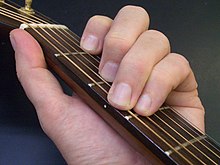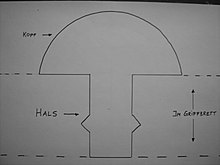Fret (string instrument)
A fret is an elevation on the fingerboard of a stringed instrument that runs across the strings and mostly across the entire width of the fingerboard. When playing, the strings are pressed onto the fingerboard with your fingers. The frets serve as supports for the strings that are picked. Through the positions of the frets, the strings can be shortened to a priori fixed fractions of their length. If the picked string is then made to vibrate, a certain higher tone sounds which corresponds to this shortening.
In today's tone system of Western music, the octave is divided into twelve semitones. Here the frets are usually positioned so that they correspond to these semitones in the equal tuning . But there are also diatonic fretted instruments and instruments with different fret spacings that produce different pitch steps.
In most western instruments today, the frets are metal chopsticks embedded in the fingerboard. In historical and non-western instruments, the frets made of cord or gut are tied across the neck , which is where the name "bundle" comes from.
general description
Frets made of string or gut are typical for lutes and viols . Frets made of wood or ivory were also in use until around the middle of the 19th century.
Today most fretted instruments such as the guitar , mandolin , ukulele and banjo have metal frets embedded in the fingerboard , mostly made of nickel silver wire or a nickel-silver alloy. They are worked into previously sawn slots across the fingerboard and, with a few exceptions, run across its entire width. Their distances to one another taper towards the body (cf. fret purity ).
There are frets in different strengths. The fret thickness is usually the same across the entire fingerboard. Above all, it must be tailored to the thickness, material and length of the strings. On a mandolin or ukulele, for example, the frets are thinner than on a guitar, and on an electric bass they are thicker.

particularities

In addition to instruments in which the frets are attached at semitone intervals , there are also instruments in which the frets are spaced differently, e.g. diatonic string instruments such as the dulcimer , in which semitone and whole-tone steps occur, instruments with so-called quarter - tone frets, as well as instruments from oriental musical traditions such as the Turkish saz , the Arabic buzuq or the Indian sitar .

With traditional and historical instruments, individual frets can also be shifted between pieces and tilted to tune the instrument into different tuning systems .
Angled frets
The system of so-called slanted frets , also known as fanned frets , can be observed in the orpheoreon , a lute-like instrument of the Renaissance , as early as the 16th century . Modern instrument makers have taken up the idea again and are successful with it. Fanned frets allow different scales on an instrument, the bass strings sound giving a much richer.
Grooved fingerboard
With the scalloped fretboard, the wood of the fingerboard between the individual frets is slightly hollowed out. As a result, the fingers have no contact with the fingerboard, but only lie lightly on the strings. This enables a differentiated tone, such as vibrato and a slight pulling (bending) of the tones. Some guitar lutes have this type of fingerboard. Some guitarists claim that this allows them to play faster.
"True Temperament" (spaghetti) frets
Some luthiers experiment with curved ("spaghetti") frets to improve the intonation of the instruments. In order for this to work convincingly, the player must ensure that the strings are always the same , identical strings and the same neck curvature, which can, however, lead to problems during the transition from one season to another or when the climate changes due to travel.
Partly fretted instruments
This rare peculiarity is usually only made at the special request of a musician, although some manufacturers also offer models with partial frets. This variant makes it possible to have the sound of an instrument with and without frets. The frets in the upper area of the fingerboard are usually missing.
Others
Especially with instruments with steel strings such as B. the electric guitar or the western guitar , after prolonged play, wear and tear occurs at the points of the frets where the strings are in contact with them. At an advanced stage, this leads to sound impurities and possibly to background noises. The frets concerned must be replaced. Fret renewals can be carried out professionally by any instrument maker.
An annoying phenomenon, that of the snarling or chirping of individual strings, appears again and again with instruments with frets. There can be different reasons:
- The action of the strings is too low so that the distance between the string and the fret is too small.
- The frets are not absolutely the same height as one another. It is then necessary to dress them.
- The neck is out of alignment. Here, too, every instrument maker knows technical remedies.
Fretless instruments
Many string instruments have no frets, for example the representatives of the violin family . With the cello and double bass , however, frets were common up to the 18th century. The oriental oud is now also a fretless lute instrument (however, music theorists such as Avicenna used fretted lutes). In some styles of popular music ( jazz , rock music ) the fretless fretless bass is used. This demands a higher degree of precision from the player in order to hit the notes on the fingerboard exactly. In addition, the sound of the instrument changes; the sound is described as “purring”, “singing” or “soft”.
Individual evidence
- ↑ "The first 10 [frets] can be made of silver or brass, but the last 5 must be made of ebony or ivory." Francesco Molino : New Guitar School . Leipzig 1826 ?, p. 7
- ↑ tollguitars.de: Expert knowledge of guitar making
- ↑ http://www.truetemperament.com
- ↑ Special features of the bundling
- ↑ L. Manik: The Arabic tone system in the Middle Ages. Leiden 1969, pp. 47-52.


